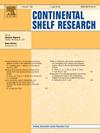Water masses distribution over the continental shelf off the Doce River (19.65°S), Southeastern Brazil: A fuzzy cluster analysis
IF 2.2
3区 地球科学
Q2 OCEANOGRAPHY
引用次数: 0
Abstract
This study investigates the seasonal variability of water masses across three sectors of the Espírito Santo Continental Shelf (ESCS): the North Sector, River Sector, and Environmental Protected Area (EPA) Sector. Utilizing a comprehensive dataset collected between November 2018 and July 2023, we applied fuzzy clustering methods to outline three water masses — Coastal Water (CW), Tropical Water (TW), and South Atlantic Central Water (SACW) — and analyze their distribution across the sectors. Our findings reveal distinct seasonal patterns in these water masses’ distribution and properties, influenced by factors like river discharge, coastal upwelling, and net heat flux. Absolute salinity distribution showed less saline river runoff water constrained to the coastal region around the Doce River mouth and eventually in the coastal North Sector due to increased continental discharge associated with reversal southerly winds. Winter is an exception to the conservative temperature and absolute salinity distribution due to the homogeneity of cold column water and the lower input of freshwater. Particularly noteworthy is the seasonal variability observed in the River Sector, where the influence of freshwater discharge from the Doce River significantly impacts water masses distribution. CW occurrence follows the distribution of absolute salinity and the area affected by the river plume, TW is associated with the Brazil Current, and SACW occurs over the continental shelf throughout the year (despite the weak thermal gradient during the winter). At the surface, TW prevails at all sectors beyond the river influence during the autumn and past the 30 m-isobath in the remaining seasons due to upwelled waters. This study provides valuable insights into the complex interactions shaping the oceanographic characteristics of the ESCS, highlighting the importance of considering seasonal variability in understanding coastal marine ecosystems.
巴西东南部多塞河(19.65°S)陆架水团分布:模糊聚类分析
本研究调查了Espírito圣大陆架(ESCS)三个部分的水团的季节变化:北段、河流段和环境保护区(EPA)段。利用2018年11月至2023年7月收集的综合数据集,我们应用模糊聚类方法概述了三种水团-沿海水(CW),热带水(TW)和南大西洋中部水(SACW) -并分析了它们在各个部门的分布。我们的研究结果揭示了这些水团分布和性质的明显季节性模式,受河流流量、沿海上升流和净热通量等因素的影响。绝对盐度分布表明,由于南风逆转导致大陆流量增加,多斯河口附近沿海地区的含盐河流径流减少,最终流入北部沿海地区。冬季是温度和绝对盐度保守分布的一个例外,这是由于冷柱水的均匀性和较低的淡水输入。特别值得注意的是在河段观测到的季节变化,其中多斯河淡水排放的影响显著地影响了水团分布。连续波的发生遵循绝对盐度的分布和受河流羽流影响的区域,TW与巴西流有关,而SACW全年发生在大陆架上空(尽管冬季热梯度较弱)。在地表,由于上升水的影响,在秋季和其余季节,TW在河流影响以外的所有扇区都普遍存在。这项研究为形成ESCS海洋学特征的复杂相互作用提供了有价值的见解,强调了在理解沿海海洋生态系统时考虑季节变化的重要性。
本文章由计算机程序翻译,如有差异,请以英文原文为准。
求助全文
约1分钟内获得全文
求助全文
来源期刊

Continental Shelf Research
地学-海洋学
CiteScore
4.30
自引率
4.30%
发文量
136
审稿时长
6.1 months
期刊介绍:
Continental Shelf Research publishes articles dealing with the biological, chemical, geological and physical oceanography of the shallow marine environment, from coastal and estuarine waters out to the shelf break. The continental shelf is a critical environment within the land-ocean continuum, and many processes, functions and problems in the continental shelf are driven by terrestrial inputs transported through the rivers and estuaries to the coastal and continental shelf areas. Manuscripts that deal with these topics must make a clear link to the continental shelf. Examples of research areas include:
Physical sedimentology and geomorphology
Geochemistry of the coastal ocean (inorganic and organic)
Marine environment and anthropogenic effects
Interaction of physical dynamics with natural and manmade shoreline features
Benthic, phytoplankton and zooplankton ecology
Coastal water and sediment quality, and ecosystem health
Benthic-pelagic coupling (physical and biogeochemical)
Interactions between physical dynamics (waves, currents, mixing, etc.) and biogeochemical cycles
Estuarine, coastal and shelf sea modelling and process studies.
 求助内容:
求助内容: 应助结果提醒方式:
应助结果提醒方式:


